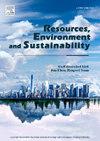Assessing carbon storage dynamics in an ecological civilization demonstration zone amid rapid urbanization: A multi-scenario study of Guizhou Province, China
IF 12.4
Q1 ENVIRONMENTAL SCIENCES
引用次数: 0
Abstract
Effective management of terrestrial ecosystems is crucial for mitigating climate change, especially in regions like Guizhou Province, where significant carbon sequestration potential is challenged by urbanization and ecological initiatives. This study simulates the spatiotemporal dynamics of carbon storage in Guizhou under multiple land use and land cover (LULC) scenarios and explores their ecological and economic impacts. Specifically, LULC and ecosystem service data were applied to assess carbon storage and habitat quality from 1990 to 2020. LULC projections from 2030 to 2060, incorporating habitat quality constraints, were generated to assess carbon storage and its economic value. The results show that Guizhou’s carbon storage increased from 3423.13 Tg to 3475.42 Tg, with forest restoration increasing it by 301.62 Tg and agricultural expansion reducing it by 218.63 Tg. Projections indicate continued growth under the current trend, with 125.19 Tg of carbon sequestration valued at 11.29 billion Chinese Yuan by 2060. Ecological initiatives could accelerate these benefits, while urban expansion may limit them. Carbon storage in different sequences of development scenarios was similar, suggesting that later development strategies can partially offset earlier differences resulting from varying priorities. Nevertheless, it remains essential to consider the sequence effects on other ecosystem services and socioeconomic factors. These findings highlight the importance of ecological engineering and reveal the flexibility in balancing ecological goals with urban development, providing guidance for long-term integrated planning to achieve sustainable development. This study provides a methodological basis for carbon storage research, supporting regional land management practices in the context of carbon neutrality.

快速城市化背景下生态文明示范区碳储量动态评估——以贵州省为例
陆地生态系统的有效管理对于减缓气候变化至关重要,特别是在像贵州省这样的地区,在那里,巨大的碳封存潜力受到城市化和生态举措的挑战。本文模拟了贵州省多种土地利用/土地覆盖情景下碳储量的时空动态变化,并探讨了不同土地利用/土地覆盖情景对生态和经济的影响。具体而言,利用1990 - 2020年LULC和生态系统服务数据对碳储量和栖息地质量进行了评估。在纳入栖息地质量约束的情况下,生成了2030年至2060年的LULC预测,以评估碳储量及其经济价值。结果表明:贵州省碳储量从3423.13 Tg增加到3475.42 Tg,其中森林恢复增加了301.62 Tg,农业扩张减少了218.63 Tg;预测显示,在目前的趋势下,碳汇将继续增长,到2060年,碳汇将达到125.19 Tg,价值112.9亿元人民币。生态倡议可以加速这些好处,而城市扩张可能会限制它们。不同发展情景序列的碳储量相似,这表明后来的发展战略可以部分抵消由于优先顺序不同而导致的早期差异。然而,仍有必要考虑序列对其他生态系统服务和社会经济因素的影响。这些发现突出了生态工程的重要性,揭示了平衡生态目标与城市发展的灵活性,为实现可持续发展的长期综合规划提供了指导。本研究为碳储量研究提供了方法论基础,为碳中和背景下的区域土地管理实践提供了支持。
本文章由计算机程序翻译,如有差异,请以英文原文为准。
求助全文
约1分钟内获得全文
求助全文
来源期刊

Resources Environment and Sustainability
Environmental Science-Environmental Science (miscellaneous)
CiteScore
15.10
自引率
0.00%
发文量
41
审稿时长
33 days
 求助内容:
求助内容: 应助结果提醒方式:
应助结果提醒方式:


